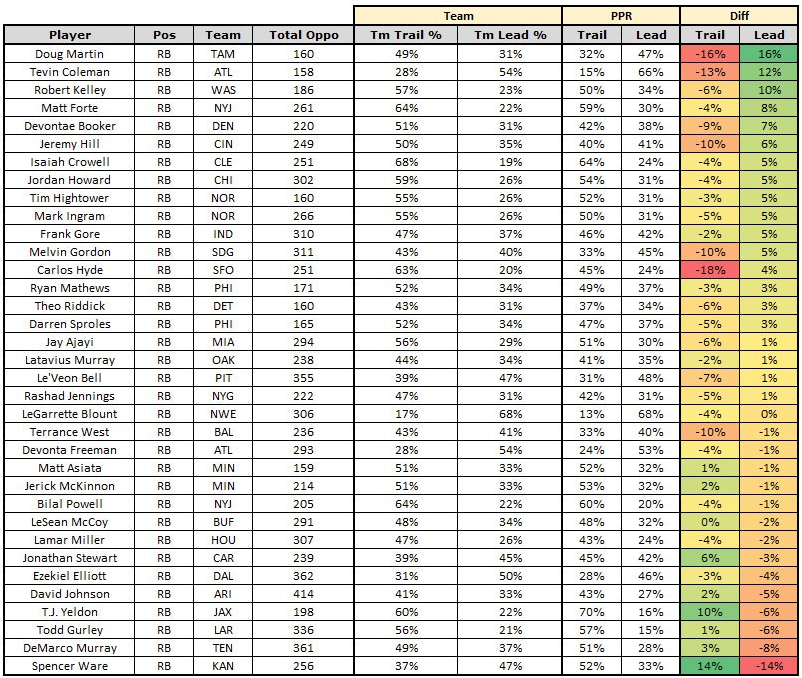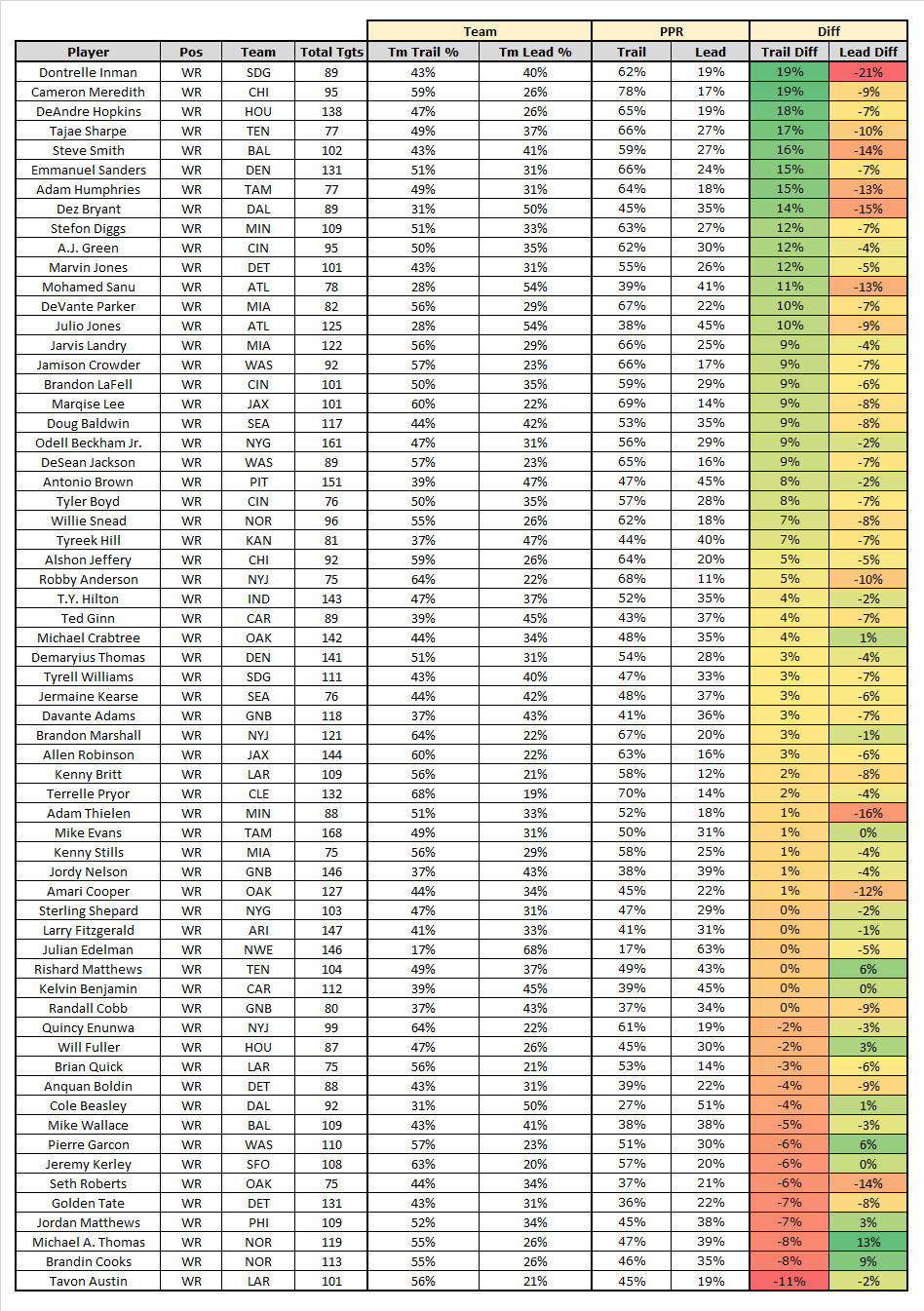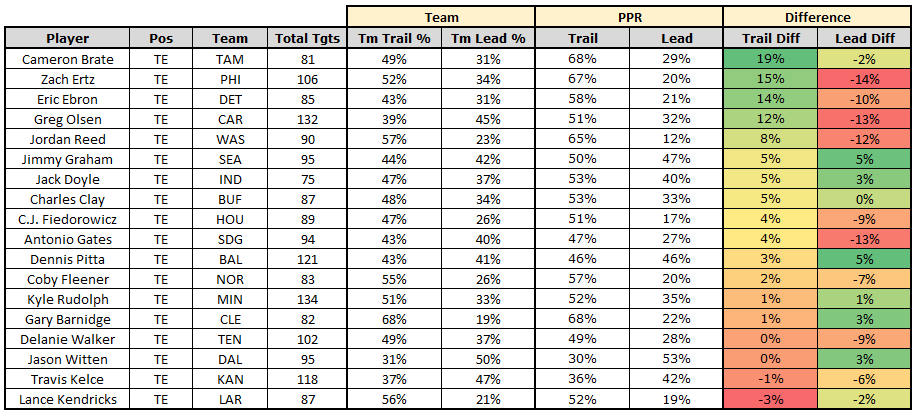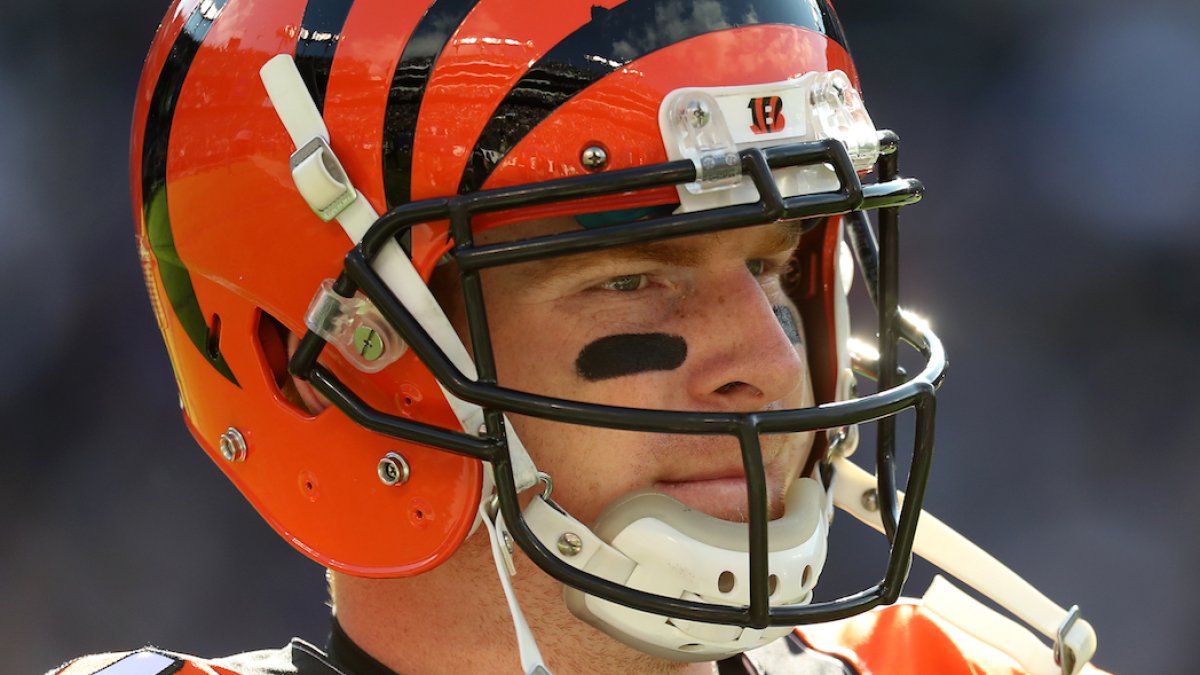(“Metrics that Matter” is a short feature that appears every Tuesday, Wednesday, and Saturday, highlighting a notable fantasy lesson to be learned from PFF’s advanced stats.)
As I mentioned in Tuesday’s article, I’ve recently started obsessing over the notion of fantasy consistency. Tuesday, we looked at weekly fantasy consistency by scoring and volume. This time, we will try to determine which players were the most or least consistent by gamescript.
In each chart below, broken down by position, I look at how often a player’s team was trailing or leading and each player’s fantasy splits in both categories. The difference between these numbers represents how much a player benefited from a specific gamescript (in this case, either leading or trailing). The more “gamescript-sensitive” players will be the ones on either end of the chart.
By determining how gamescript-dependent a player was last season, we should be able to make some educated guesses about their role next season. If a team’s quarterback scored a high percentage of his fantasy points when trailing last season, and the inverse was true for the running back, we might surmise that the team “played it safe” when ahead in games. This might mean if the team had a game against the Patriots (unlikely to be leading), the quarterback might be an interesting and underpriced DFS play that week. From a redraft perspective, we might be able to go even further with this. Since that running back scored a high percentage of his fantasy points when leading, if that team were projected to improve significantly this season, he might be an interesting buy-low candidate in redraft leagues.
Quarterbacks

As evident in the chart above, quarterbacks are typically far more productive when trailing. This makes sense intuitively — when there’s more of an urgency to put points on the board, teams will run less and throw more. Last season, on average, teams passed 66 percent of the time when trailing, but only 51 percent of the time when leading.
Last season, Alex Smith, Derek Carr, and Andy Dalton were three of the most gamescript-sensitive quarterbacks by fantasy production last season. This was backed up by volume splits as well. Only 36 percent of Smith's pass attempts came when the team was leading, though his team led 47 percent of the time. Dalton's splits were large as well, though less glaring. His team trailed 50 percent of the time last season, but 57 percent of his pass attempts came when trailing. Carr’s splits were far less glaring in terms of volume, so I’m mostly chalking up his ranking here to variance.
The fantasy implication for Dalton and Smith would be to target these two players as cheap quarterback options in weeks we can expect them to be trailing (I’d consult our box-score projections for this.) I’m not reading too much into Drew Brees’ and Ben Roethlisberger’s rankings on the other end of the spectrum, but it is encouraging the team didn’t seem to hold them back when leading. Roethlisberger’s gamescript consistency was particularly impressive. The Steelers led on 47 percent of their plays and trailed on 39 percent of their plays; 47 percent of Roethlisberger’s pass attempts came when leading and 39 percent came when trailing. However, Roethlisberger is still one of the league’s most inconsistent quarterbacks for an entirely different reason.
Running backs

While all other positions benefited from negative gamescript, the opposite was true for running backs. Last season, the most gamescript-sensitive running backs were Doug Martin, Tevin Coleman, Robert Kelley, Matt Forte, Jeremy Hill, and Carlos Hyde. All of these names, outside of Coleman, make perfect sense. None of these running backs are strong pass-catchers, so when the team is trailing (teams run more frequently when leading) they’ll pull out their workhorse and substitute in a more-capable pass-catching back (Chris Thompson, Bilal Powell, Giovani Bernard, etc.) When the team is leading, they’ll go run-heavy and let their workhorse dominate touches and take time off the clock. I’m not sure why Coleman found his way onto this list, but the volume backs it up as well. Atlanta led 54 percent of the time last season, and 66 percent of his carries came when Atlanta held a lead. Perhaps when Atlanta carried a lead, they went more run-heavy and were more likely to give him playing time over Devonta Freeman.
David Johnson and DeMarco Murray’s rankings on the other side of the spectrum are particularly interesting. Both were used as their team’s bell-cow running backs and saw a larger workload in the passing game when trailing. 49 percent of Johnson's targets came when the team was trailing, even though Arizona trailed only 41 percent of the time. The Titans, meanwhile, led 37 percent of the time, and Murray saw just 29 percent of his targets when leading. In PPR leagues, the average running back carry is worth 0.59 expected fantasy points, while the average target is worth 1.57 expected fantasy points. Those extra targets made a significant impact on both running backs, but this was especially the case for Spencer Ware, who saw 52 percent of his targets when the team was trailing, though Kansas City trailed only 37 percent of the time.
Pat Thorman wrote about the significance of late game flow for running backs here.
Wide receivers

Like with quarterbacks, you’ll see all wide receivers benefited greatly when their team was trailing. This makes sense considering how heavily tied a wide receiver’s production is to their quarterback. For this reason, I’m not sure how many takeaways there are here that weren’t already covered in the quarterbacks section. You’ll certainly notice some overlap between the two charts — wide receivers like A.J. Green and Doug Baldwin benefited greatly from negative gamescripts, as did their quarterbacks in the first section. For less highly variable receivers it may be a sign that the team made a more concerted effort to keep them involved even when the gamescript did not dictate this.
Tight ends

With tight ends, we see a similar trend to wide receivers — an increase in scoring when trailing. Due to their dual-role as blockers and receivers, the tight end position is a little more intriguing than with wide receivers. Eric Ebron was the third-most gamescript-sensitive tight end. He was asked to pass-block on 8.0 percent of the team’s passing plays in victories, and only 3.3 percent in losses. Greg Olsen’s blocking splits were even more dramatic. He was asked to pass-block 16.6 percent of the time in victories, but only 9.9 percent in losses.
Cameron Brate was easily the most gamescript-dependent tight end in terms of both volume and production. 68 percent of his targets came when the team was trailing, though they trailed on only 49 percent of their snaps. Kelce’s ranking here was a bit of a surprise given how much Alex Smith benefited from negative gamescript in our first chart.



 © 2025 PFF - all rights reserved.
© 2025 PFF - all rights reserved.